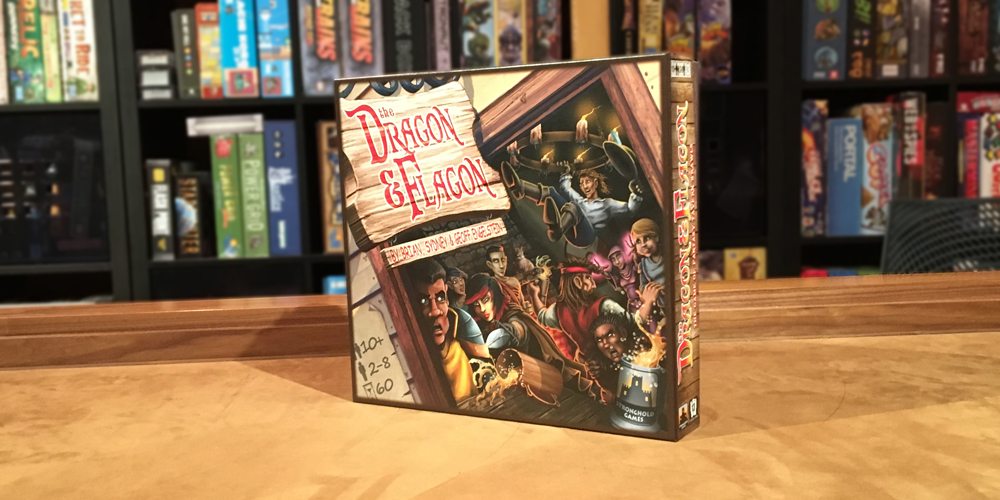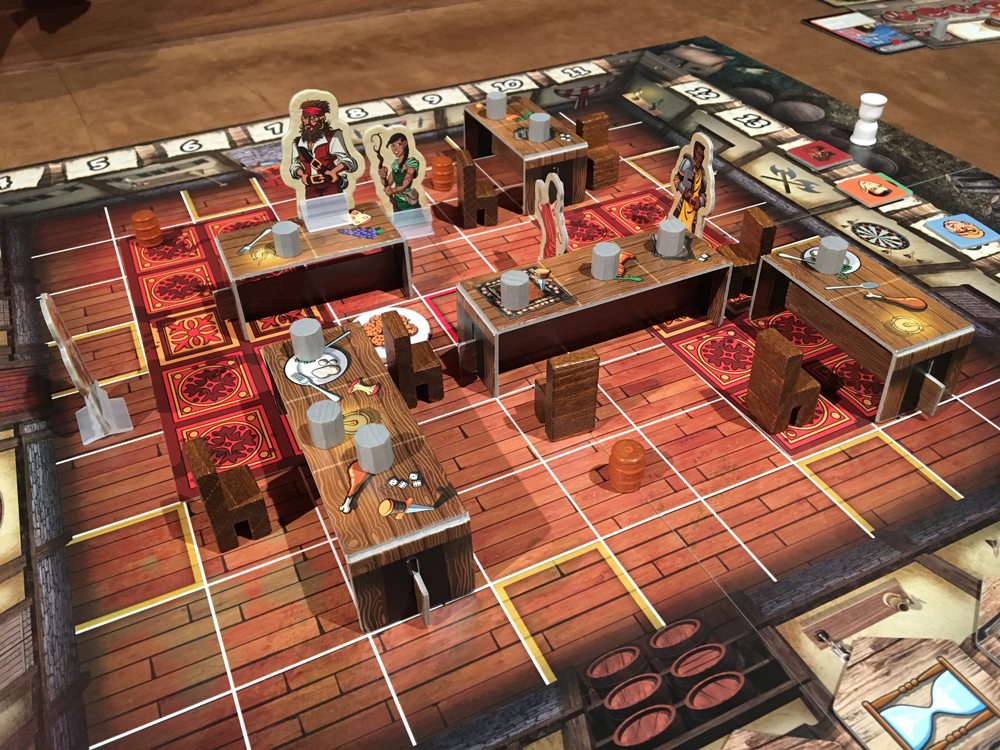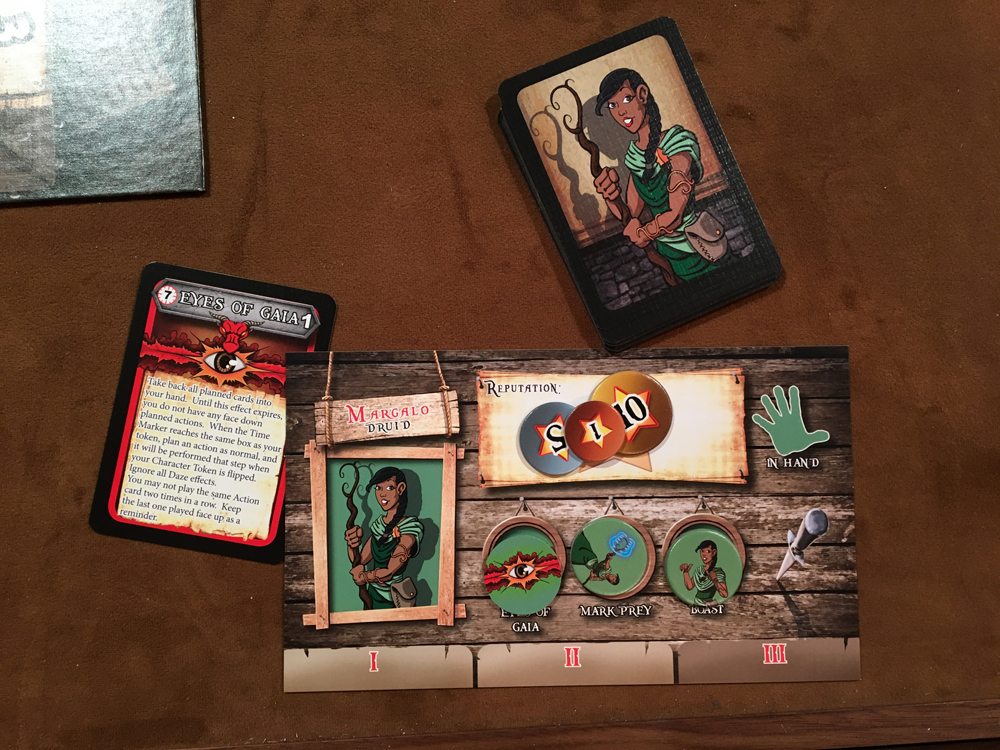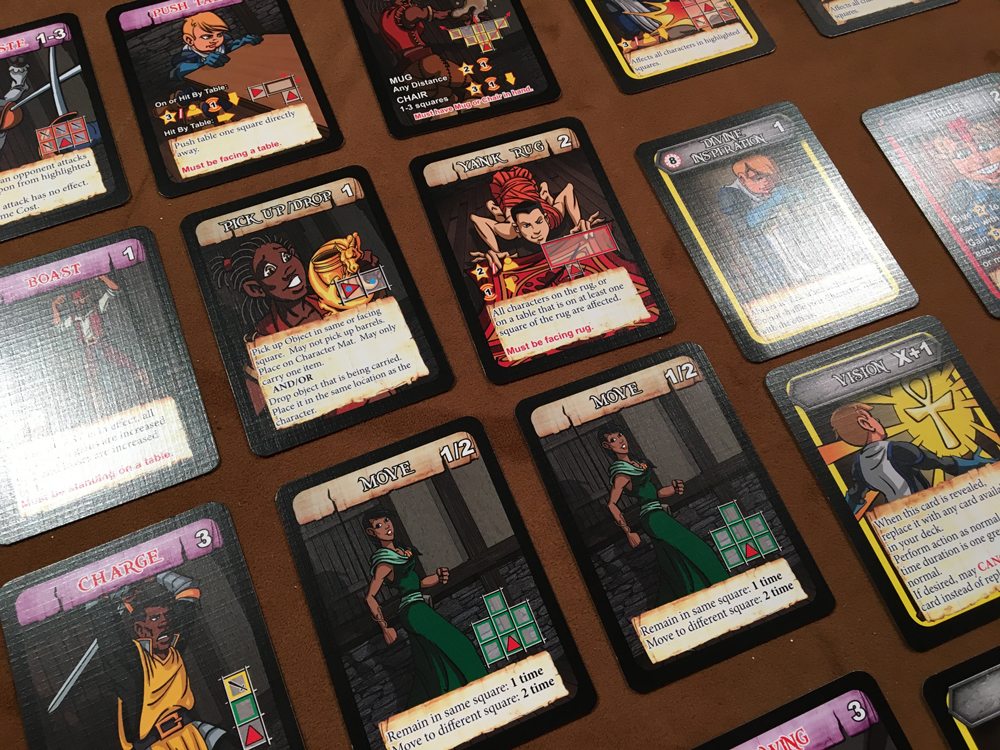
At a Glance
At the Dragon & Flagon, a renowned tavern , a drink is served–the Dragon. This libation is so powerful, it will give adventurers powers beyond their wildest dreams. However, on the night you’ve arrived, there is but one drink left. Mayhem immediately ensues as chairs are thrown, rugs pulled, and swords thrust as players compete to get their hands on the Dragon.
In The Dragon & Flagon, a bar brawl game for 2-8 players, age 10 and up, players compete to do the most damage, earn the most reputation, and emerge victorious (in 60 minutes or less).
Components
There’s a lot here and some of it is pretty unique. In the box, you’ll find:
- 3 small, 3-D tables
- 2 large, 3-D tabes
- 1 two-sided gameboard
- 2 rugs (though the rulebook lists 4, this is a misprint)
- 4 game end tokens
- 70 reputation tokens, with various values
- 9 character mats
- 9 character standees
- 21 status tokens
- 162 character cards (nine decks of 18 cards)
- 9 character tokens and plastic stands
- 4 wooden barrels
- 12 wooden mugs
- 9 wooden chairs
- 1 time token
- 1 Dragon Flagon standee
- 1 plate of cookies
- 6 Treasure Chests (for play on pirate brawl side of board)
The components are pretty brilliant and absolutely what will draw observers to your table–who wouldn’t want to find out more about a board that looks like a three-dimensional tavern, complete with tables, chairs, and mugs? The A-side of the gameboard, the inside of the tavern, is fantastic. The B-side, pirate brawl, a bit less so, but only because it’s missing some of the ambiance of the bar.
The cardboard is all of very good quality, as are the cards. The standees are nice and the barrels, chairs, and mugs do a good job of playing their parts in the setting. The rugs and character mats are simply heavy paper, which leaves you wanting a bit more, but there’s so much else here and it’s difficult to imagine how else to do them while keeping costs down, that The Dragon & Flagon gets a pass on those.
The tables are printed with plates and food and, wow, when the board is all set up, it really feels as though you’ve stepped into the warmth and underlying tension of an adventurer’s tavern.

How to Play
Setup is fairly simple. Players pick a character. If four or fewer are playing, each person gets two characters. If it’s five or more, they just get one. Players get the corresponding player mat, standee, character token, 18 card deck (each player has a special Dragon card that’s set aside), and status tokens. Each player also starts the game with 20 reputation tokens, all of which is placed in front of each player.
The tavern can really be set up in any way you choose. Yellow outlines mark where players start the game, but it’s up to you where the rugs, tables, chairs, barrels, and mugs go. The Dragon goes in the middle of the board. (Note: if you want to play your bar brawl in a more family-friendly way, replace the intoxicating Flagon with a lovely plate of cookies.
There are four game-end tokens, one of which shows guards and ends the game, the others just delay the end. These should be flipped, shuffled and placed in the 21-24 spots on the time track of the board (or 27-30 if you want to play a longer game).
Character tokens are shuffled and placed, face-down, on the first spot of the time track, along with the time marker. Character standees are placed somewhere close to the players, within a yellow-outlined square of the tavern and play is almost ready to begin.
Before the first turn, players preprogram two actions they want to take by selecting cards from their decks. They place the cards at specific locations on their player mat and the cards are then locked, resolving in the order placed.
The game takes place over an unspecified number of rounds. Each round, the shuffled character tiles are revealed, showing whose turn it is. On a turn, the player programs empty action slots (if there are any for the first or second slot on his player mat) he then reveals his card and performs the action on the card. Before ending his turn, he has the option of freely turning the way his standee is facing on the board. This is important because future actions are dependent on the direction the standee is facing. He then moves his player token a number of spaces on the time track, as specified on the action card’s time cost.

Once all players have performed their actions on a slot on the time track, the time marker is moved to the next slot that has character tokens on it. The tokens are hidden and shuffled and the next round begins. In this manner, turns play out similarly to Patchwork so that a player may go multiple times before another player, depending on the actions being taken and time cost incurred.
Action cards show the card’s name and a time cost. Some cards also show squares on the board that are affected by the action, lasting effects of the action and its duration, a description, or requirement. Additionally, some cards knock back opponents, knock them down, or daze them. A player that is knocked back moves her standee a space away from the attack. If her standee hits another standee behind her, it is also knocked back.
A player who is knocked down has to give up his next action, take a time penalty of one, and spend the next turn standing up. A player who is dazed has to immediately program the number of cards dictated on the action card, up to three actions. Most importantly, the action cards might show a reputation effect. If you’ve injured your opponent in some way, the action card might have a star on it, which indicates the amount of reputation that the affected player must pay you from his supply.
Should a situation change since programming (and it will happen, sometimes often) and a player is no longer able to meet the conditions dictated by the card, the action is cancelled and the player takes a hit for one time instead of what is on the card. If you meet the requirements of an action card, you have to play the action, even if it doesn’t work to your advantage.
If movement conveys you into a table, you move on top of it, there is no additional movement cost to move up or down. Objects like chairs, barrels, and mugs don’t obstruct movement. A player can pick up mugs and chairs, but can only carry a single object at once. Any chair or mug that’s thrown is removed from the game. If a player picks up the Dragon Flagon (or plate of the cookies), she is also allowed to pick up her special Dragon card and use it like a regular action. However, once the Dragon card is used, it’s set aside until the player picks up the Dragon Flagon again.
Action cards involve a number of common cards like movement, simple attacks, pick up/drop items, throwing objects, pushing tables, and yanking rugs. Each player also has four unique actions, in addition to their Dragon card. The cards do an excellent job of outlining how the cards work and there is further definition in the rule book.
There are a couple of variants to the game, including team play, and a whole other game, Pirate Brawl, on the other side of the board. It has its own set of rules, which are located here. (PDF)
Play continues with swords, chairs, fists, and mugs flying, players getting knocked down and more until the time marker reaches the Game End tokens. When the actions for that round are completed, the Game End token is flipped. If there are guards on the opposite side, the game ends, reputation is added up, and the most points wins.

Why You Should Play
Whew! There’s a lot to explaining this game. And to be honest, the rulebook is a bit intimidating at first. But, in reality, the game is very easy to learn and play. After everyone’s first turn, play will move along at a quick clip and you’ll be busting barroom heads like a medieval James Dalton.
We’ve played this game a half-dozen times now and it is far more fun with a larger group than trying to be responsible for a couple of characters in a smaller group. What’s also been interesting over the course of those games is how players interact with the game environment. I’ve played games where players pick up and throw everything they can get their hands on, push tables, and yank rugs. Other games, players concentrate on melee-like strategies. Either way, the game offers a rewarding experience.
In some games, players have become frustrated because they were constantly being pushed back on their heels, getting knocked down, and losing any sort of semblance of a plan. While I argued that this is representative of a bar fight, I can see where never really being able to mount an offensive would be frustrating. However, it’s not something I experienced in my strategies. I asked this player what they would change about the game to fix their issue and they suggested only programming a single action in advance. I plan on trying it out, but two action programming seems to work pretty well, as it is.
When you play with five or six players, play moves quickly enough that you’ll be done well inside the suggested 60-minute time frame. This is one of The Dragon & Flagon‘s winning attributes; play really moves quickly. However, with new players or those prone to analysis paralysis, you may experience long waits as players peruse their deck, trying to find an action to play. Sand timers are a wonderful thing to have on hand.
The modular board presents nearly endless variations for gameplay. Want to be devious? Place the Dragon Flagon on a couple rugs in the middle of the room. Want more? Surround it completely by tables. Place all the mugs in one corner. You can have lots of fun with the setup alone.
It’s a fun game and one that even my non-gaming daughters got excited about. Beat each other up in a tavern brawl? Awesome! The very spectacle of a boardgame with tables, chairs, barrels, mugs, and standees is enough to pique the interest of most people… and the next thing you know, you have a full complement of eight adventurous fools screaming like banshees and rushing headlong into each other inside the Dragon & Flagon.
But the best part is that The Dragon & Flagon was designed by Geoff Engelstein (Space Cadet games, Survive: Space Attack!) designed it with his kids, Sydney and Brian, as he has most of his other games. And, from a GeekDad perspective, that’s just really neat.
The Dragon & Flagon is available now.

Disclosure: GeekDad received a sample of this game for review purposes.




